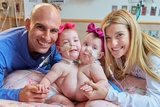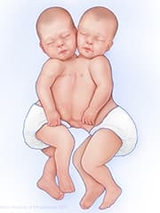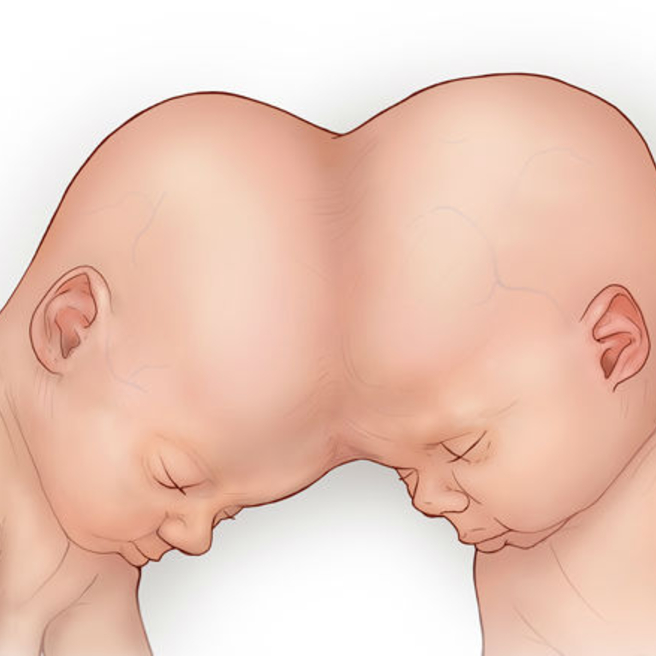
After nearly a year in intensive care at Children’s Hospital of Philadelphia (CHOP), 10-month-old conjoined twins Addison (Addy) and Lilianna (Lily) Altobelli were successfully separated by CHOP surgeons on October 13, 2021. Now home in Chicago, the girls were born connected at the abdomen and chest, a condition known as thoraco-omphalopagus twins, meaning they shared a liver, diaphragm, chest and abdominal wall.

A surgical team that involved more than two dozen specialists, including general surgeons, anesthesiologists, radiologists, a cardiothoracic surgeon, and plastic surgeons, spent approximately 10 hours separating the girls. Once the twins had been separated, the surgical team divided in two and rebuilt each girl’s chest and abdominal wall, using layers of mesh and plastic surgery techniques to stabilize each infant.
“Separating conjoined twins is always a challenge because every single set of twins is unique, and they all have different challenges and anatomic considerations,” said lead surgeon Holly L. Hedrick, MD, an attending pediatric and fetal surgeon in the Division of Pediatric General, Thoracic and Fetal Surgery at Children’s Hospital of Philadelphia. “The way our team works together, it’s really incredible and special, with so many people coming together to work toward a common goal. Addy and Lily are doing well, and our hope is that they have full lives that are joyful.”
From diagnosis to delivery
Addy and Lily’s journey began when they were diagnosed prenatally at their 20-week ultrasound appointment. Before that appointment, parents Maggie and Dom Altobelli had assumed they were having one baby, but the ultrasound image showed that not only was Maggie carrying two fetuses but they were also attached at the abdomen.
Conjoined twins are rare, occurring in only about 1 in 50,000 births. The couple was referred to CHOP for further evaluation, since the hospital is one of only a few in the country with experience separating conjoined twins. More than 28 pairs of conjoined twins have been separated at CHOP since 1957, the most of any hospital in the country.

The couple met with specialists in CHOP’s Richard D. Wood Jr. Center for Fetal Diagnosis and Treatment, where Maggie underwent extensive prenatal testing to determine if it was possible to separate the twins, based on their connection and shared anatomy. Doctors discovered that although the girls shared a chest and abdominal wall, diaphragm, and liver, the twins had separate, healthy hearts. Their shared liver was also large enough to divide between them, making them excellent candidates for separation surgery.
After months of planning for a high-risk delivery via C-section, led by Julie S. Moldenhauer, MD, Director of Obstetrical Services, Addy and Lily were born on November 18, 2020 in the Garbose Family Special Delivery Unit (SDU), CHOP’s inpatient delivery unit. They spent four months in the Newborn/Infant Intensive Care Unit (N/IICU), followed by six months in the Pediatric Intensive Care Unit (PICU). CHOP plastic surgeon David W. Low, MD, inserted skin expanders to stretch the girls’ skin in preparation for separation surgery. Like small, collapsible balloons, the skin expanders gradually expand through injections, stretching the skin slowly over time so that each girl would have enough skin to cover her exposed chest wall and abdomen after separation.
A complex surgery
Once the twins were stable and there was enough skin for adequate coverage post-separation, they were ready for surgery. A month before the surgery, the surgical team met every week, reviewing the ultrasound images again and again to study the blood supply to the girls’ livers, so that they could map out the blood flow and where the girls’ vasculature crossed. CHOP radiologists created 3D models, which were put together like Lego® pieces, so that the surgical team could understand the relationship of the girls’ shared anatomy and practice the surgery in walk-through exercises, like dress rehearsals for the day of surgery.
On October 13, 2021, after months of preparation, Addy and Lily underwent a 10-hour surgery and were officially separated at 2:38 p.m. Radiology was on hand during the surgery to map out the important liver structures with ultrasound. Once the girls were separated, the surgical team divided in two and got to work stabilizing each girl and rebuilding her chest and abdominal wall. Stephanie Fuller, MD, a cardiothoracic surgeon, ligated the girls’ patent ductus arteriosus and made sure both girls’ hearts were in the right position and functioning well. Plastic surgeons placed two layers of mesh – one temporary, one permanent – over the twins’ abdominal and chest walls and then covered that with the skin that had been stretched over months while the girls were in the PICU.
When the girls were out of surgery, Maggie and Dom saw their daughters separated for the first time.
“To see them with their own bodies – their bodies were just so perfect – it was amazing,” said Maggie. “It was just indescribable.”
Home for the holidays

On December 1, 2021, the Altobellis finally flew home to Chicago – one twin at a time, with one parent each – after living in Philadelphia for more than a year. The twins spent two weeks at Lurie Children’s Hospital under the care of the medical team that will support them closer to home. The girls were discharged just in time for Christmas and arrived home to find their yard decorated by their neighbors. They spent the holiday together at home as a family of four.
Addy and Lily both still have tracheostomy tubes and ventilators to help with their breathing, as they will need time to develop musculature and adjust to breathing on their own. In time, they will be weaned off the ventilators.
“We’re starting a new book – it’s not even a new chapter, it’s a new book,” said Dom. “We started a brand-new book for the girls, and there's an Addy book, and there's a Lily book.”
Watch the video below to follow along on their journey or read their full story here.
The surgical team consisted of surgeons, anesthesiologists, nurses and others, including: Surgeons: Holly Hedrick, MD, Alan Flake, MD, David Low, MD, Avery Rossidis, MD, Niv Milbar, MD, Monica Llado-Farrulla, MD, and Patrick McGovern, MD. Anesthesiologists: Alison Reed Perate, MD, Rodrigo Javier Daly Guris, MD, and Natalie Neiswinter, MD. Nurses: Megan Colline, Leigh Casella, Hien Lam, Rasheda Kent, Christine Hopkins, Jillian Bacher, and Francesca Drake. Physician assistant: Elizabeth Trovato, PA-C. Core tech: Cleon Gary.
Featured in this article
Specialties & Programs
After nearly a year in intensive care at Children’s Hospital of Philadelphia (CHOP), 10-month-old conjoined twins Addison (Addy) and Lilianna (Lily) Altobelli were successfully separated by CHOP surgeons on October 13, 2021. Now home in Chicago, the girls were born connected at the abdomen and chest, a condition known as thoraco-omphalopagus twins, meaning they shared a liver, diaphragm, chest and abdominal wall.

A surgical team that involved more than two dozen specialists, including general surgeons, anesthesiologists, radiologists, a cardiothoracic surgeon, and plastic surgeons, spent approximately 10 hours separating the girls. Once the twins had been separated, the surgical team divided in two and rebuilt each girl’s chest and abdominal wall, using layers of mesh and plastic surgery techniques to stabilize each infant.
“Separating conjoined twins is always a challenge because every single set of twins is unique, and they all have different challenges and anatomic considerations,” said lead surgeon Holly L. Hedrick, MD, an attending pediatric and fetal surgeon in the Division of Pediatric General, Thoracic and Fetal Surgery at Children’s Hospital of Philadelphia. “The way our team works together, it’s really incredible and special, with so many people coming together to work toward a common goal. Addy and Lily are doing well, and our hope is that they have full lives that are joyful.”
From diagnosis to delivery
Addy and Lily’s journey began when they were diagnosed prenatally at their 20-week ultrasound appointment. Before that appointment, parents Maggie and Dom Altobelli had assumed they were having one baby, but the ultrasound image showed that not only was Maggie carrying two fetuses but they were also attached at the abdomen.
Conjoined twins are rare, occurring in only about 1 in 50,000 births. The couple was referred to CHOP for further evaluation, since the hospital is one of only a few in the country with experience separating conjoined twins. More than 28 pairs of conjoined twins have been separated at CHOP since 1957, the most of any hospital in the country.

The couple met with specialists in CHOP’s Richard D. Wood Jr. Center for Fetal Diagnosis and Treatment, where Maggie underwent extensive prenatal testing to determine if it was possible to separate the twins, based on their connection and shared anatomy. Doctors discovered that although the girls shared a chest and abdominal wall, diaphragm, and liver, the twins had separate, healthy hearts. Their shared liver was also large enough to divide between them, making them excellent candidates for separation surgery.
After months of planning for a high-risk delivery via C-section, led by Julie S. Moldenhauer, MD, Director of Obstetrical Services, Addy and Lily were born on November 18, 2020 in the Garbose Family Special Delivery Unit (SDU), CHOP’s inpatient delivery unit. They spent four months in the Newborn/Infant Intensive Care Unit (N/IICU), followed by six months in the Pediatric Intensive Care Unit (PICU). CHOP plastic surgeon David W. Low, MD, inserted skin expanders to stretch the girls’ skin in preparation for separation surgery. Like small, collapsible balloons, the skin expanders gradually expand through injections, stretching the skin slowly over time so that each girl would have enough skin to cover her exposed chest wall and abdomen after separation.
A complex surgery
Once the twins were stable and there was enough skin for adequate coverage post-separation, they were ready for surgery. A month before the surgery, the surgical team met every week, reviewing the ultrasound images again and again to study the blood supply to the girls’ livers, so that they could map out the blood flow and where the girls’ vasculature crossed. CHOP radiologists created 3D models, which were put together like Lego® pieces, so that the surgical team could understand the relationship of the girls’ shared anatomy and practice the surgery in walk-through exercises, like dress rehearsals for the day of surgery.
On October 13, 2021, after months of preparation, Addy and Lily underwent a 10-hour surgery and were officially separated at 2:38 p.m. Radiology was on hand during the surgery to map out the important liver structures with ultrasound. Once the girls were separated, the surgical team divided in two and got to work stabilizing each girl and rebuilding her chest and abdominal wall. Stephanie Fuller, MD, a cardiothoracic surgeon, ligated the girls’ patent ductus arteriosus and made sure both girls’ hearts were in the right position and functioning well. Plastic surgeons placed two layers of mesh – one temporary, one permanent – over the twins’ abdominal and chest walls and then covered that with the skin that had been stretched over months while the girls were in the PICU.
When the girls were out of surgery, Maggie and Dom saw their daughters separated for the first time.
“To see them with their own bodies – their bodies were just so perfect – it was amazing,” said Maggie. “It was just indescribable.”
Home for the holidays

On December 1, 2021, the Altobellis finally flew home to Chicago – one twin at a time, with one parent each – after living in Philadelphia for more than a year. The twins spent two weeks at Lurie Children’s Hospital under the care of the medical team that will support them closer to home. The girls were discharged just in time for Christmas and arrived home to find their yard decorated by their neighbors. They spent the holiday together at home as a family of four.
Addy and Lily both still have tracheostomy tubes and ventilators to help with their breathing, as they will need time to develop musculature and adjust to breathing on their own. In time, they will be weaned off the ventilators.
“We’re starting a new book – it’s not even a new chapter, it’s a new book,” said Dom. “We started a brand-new book for the girls, and there's an Addy book, and there's a Lily book.”
Watch the video below to follow along on their journey or read their full story here.
The surgical team consisted of surgeons, anesthesiologists, nurses and others, including: Surgeons: Holly Hedrick, MD, Alan Flake, MD, David Low, MD, Avery Rossidis, MD, Niv Milbar, MD, Monica Llado-Farrulla, MD, and Patrick McGovern, MD. Anesthesiologists: Alison Reed Perate, MD, Rodrigo Javier Daly Guris, MD, and Natalie Neiswinter, MD. Nurses: Megan Colline, Leigh Casella, Hien Lam, Rasheda Kent, Christine Hopkins, Jillian Bacher, and Francesca Drake. Physician assistant: Elizabeth Trovato, PA-C. Core tech: Cleon Gary.
Recommended reading
Conjoined Twins

Conjoined twins are twins that are born with their bodies physically connected.
Contact us
Ashley Moore
Richard D. Wood Jr. Center for Fetal Diagnosis and Treatment